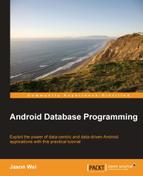So, we've reached the end but before we part, let's take a look from start to finish at all the incredible things we've learned and covered. We started this book by looking at various local storage methods on Android – methods that were extremely light-weight and efficient, as well as methods like the SQLite database, which were more complex but at the same time much more powerful.
We then took a deeper look at the SQLite database – likely the most common form of local data storage that you'll encounter in your Android application development careers, before moving onto SQL queries in Chapter 3, SQLite Queries. Next, we learned about ways in which we could expose our SQLite databases to external applications through wrapping them in content providers. Then we took a look at the most popular content provider on the Android OS – the Contacts content provider, and implemented some common queries that one might encounter.
Once we had completely mastered local storage methods, we moved on to actually binding these local data sources to the user interface through various ListAdapter classes. It was in this chapter that we saw implementations and use cases of both the CursorAdapter as well as the BaseAdapter.
From there we moved onto a more holistic look at data-centric application design and programming. We talked about practical ways in which we could use all the various forms of local data storage, and also introduced the notion of a cache as one extremely practical use case for a SQLite database. This naturally transitioned us into considering external databases, as caches typically go hand in hand with web requests and web programming.
It was with external databases that we ended our book. We discussed different kinds of external databases that we could use and decided to stick with Google App Engine (GAE) for our sample implementation. It was with GAE that we implemented a fully-functional JDO database (all done in the cloud), at which point we also implemented a series of HTTP servlets that would allow us to make HTTP GET and POST requests. And finally, we ended the book by implementing the code for the mobile side of our application – bringing us full circle and back to Android.
It's my hope that through all this, we can better see how databases, both local and external, fit into the grand scheme of developing powerful, data-centric Android applications. Best of luck and happy developing.
